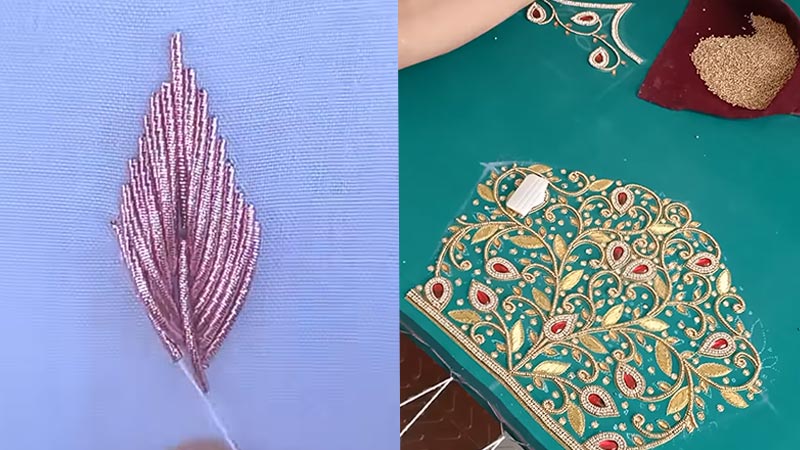The world of Indian embroidery is a captivating tapestry of intricate designs and skilled craftsmanship.
Among the most celebrated techniques are Aari and Zardosi, each with its unique history, techniques, and aesthetic appeal.
While often mentioned together, understanding the nuances that differentiate these two styles can unlock a deeper appreciation for the artistry and heritage they represent.
This article will explore the origins, tools, materials, and design styles of Aari and Zardosi, allowing you to confidently discern their distinct beauty and make informed choices when selecting these exquisite embroideries.

Aari Work: A Legacy of Delicate Artistry
- Origin:
- Originates from the heart of India, with a rich heritage dating back centuries.
- Initially flourished in the Kashmir region, later spreading to Punjab and Rajasthan.
- Technique:
- Also known as Maggam work.
- Involves delicate and intricate embroidery techniques.
- Primarily uses the Aari or Maggam needle, which features a hook at its tip.
- The hook facilitates the creation of chain stitches as the foundation of the designs.
- Designs:
- Known for its elaborate patterns.
- Often includes beads, sequins, and stones to add sparkle and dimension.
- Works well on luxurious fabrics like silk, velvet, and chiffon.
- Applications:
- Versatile in nature, suitable for both daily wear and special occasions.
- Frequently used for embellishing garments such as sarees, salwar kameez, and dupattas.
- Can also be seen in home decor like cushions, bedcovers, and wall hangings.
- Cultural Significance:
- A symbol of traditional Indian craftsmanship.
- Reflects the artistic heritage of the regions where it originated.
- Popular in weddings, festivals, and cultural celebrations due to its intricate beauty.
- Modern Influence:
- Continues to be cherished in contemporary fashion.
- Evolving designs blend traditional techniques with modern aesthetics.
Zardosi: The Opulence of Gold Embroidery:
- Origin:
- The name “Zardosi” means “gold embroidery”.
- Hails from ancient Persia, introduced to India during the Mughal era.
- Became deeply intertwined with Indian craftsmanship and royal attire.
- Technique:
- Distinguishable by the use of metallic threads, primarily gold and silver.
- Uses a traditional needle and thread, rather than a specialized needle like Aari work.
- The embroidery is painstakingly crafted, creating intricate and detailed patterns.
- Materials:
- Often incorporates beads, sequins, and precious stones.
- These additions provide depth, texture, and a three-dimensional effect to the designs.
- Designs:
- Known for its intricate patterns that are both elegant and regal.
- Embellishes fabric in a way that exudes luxury and opulence.
- Common motifs include floral, paisley, and geometric designs.
- Applications:
- Primarily used for bridal wear, lehenga cholis, and festive attire.
- Adorns ceremonial garments and royal costumes, making it ideal for weddings and grand celebrations.
- Also used in home decor, such as cushion covers, curtains, and table runners, for a luxurious touch.
- Cultural Significance:
- Symbolizes elegance, celebration, and royalty.
- A symbol of Indian opulence and cultural heritage, often associated with the grandeur of the Mughal Empire.
- Modern Influence:
- Continues to be a popular choice for wedding attire and fashion design.
- Modern interpretations of Zardosi work combine traditional techniques with contemporary fashion trends.
Key Differences Between Aari and Zardosi
To truly appreciate the individuality of these techniques, let’s examine their key distinctions:
- Origin: Aari work is indigenous to India, while Zardosi originated in Persia.
- Tools: Aari utilizes a specialized hooked needle, while Zardosi employs a traditional needle and thread.
- Threads: Aari typically uses silk and metallic threads, while Zardosi features gold and silver threads along with silk.
- Design Style: Aari designs are known for their delicacy and intricacy, while Zardosi showcases elaborate and luxurious patterns.
Choosing the Perfect Embroidery
Aari work is an ideal choice for those seeking a delicate, detailed, and versatile embroidery style. Its use of silk threads offers a subtle shimmer, perfect for both casual and semi-formal occasions.
Zardosi, with its opulent embellishments and metallic threads, is best suited for those seeking a grand and luxurious aesthetic. It is a perfect choice for bridal wear, festive attire, and statement pieces that demand attention.
Ultimately, the choice between Aari and Zardosi depends on personal preference, occasion, and the desired visual impact.
The Enduring Legacy of Aari and Zardosi
Aari and Zardosi, despite their differences, share a common thread: they embody the rich heritage and artistry of Indian craftsmanship.
Passed down through generations, these techniques continue to thrive, embellishing garments and home décor with timeless elegance.
Whether you are captivated by the delicate beauty of Aari or the regal splendor of Zardosi, these embroidery styles are a testament to the skill and creativity of the artisans who bring them to life.
Call to Action:
Embrace the beauty of Aari and Zardosi. Explore the collections of renowned designers and boutiques specializing in these exquisite embroideries.
Commission a custom-designed piece that reflects your unique style and vision. These timeless techniques are sure to elevate your wardrobe and home décor, adding a touch of heritage and sophistication to your life.
Enhanced FAQ:
Q: What type of fabric is best suited for Aari work?
A: Aari work is often seen on silk, velvet, and georgette fabrics.
Q: Is Zardosi embroidery only used on garments?
A: While primarily associated with clothing, Zardosi is also used to embellish accessories like bags and footwear.
Q: Where can I find authentic Aari and Zardosi embroidery?
A: Reputable online retailers specializing in Indian ethnic wear and boutiques showcasing traditional crafts often offer a wide selection.
Leave a Reply